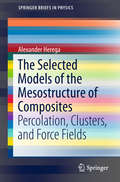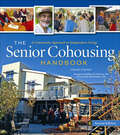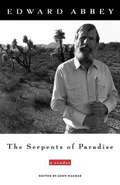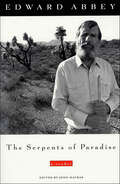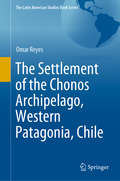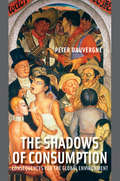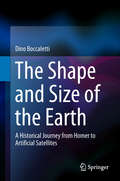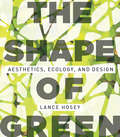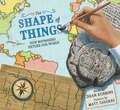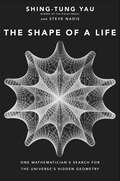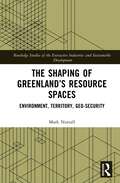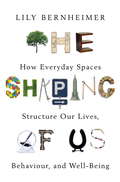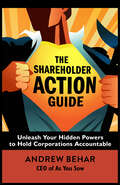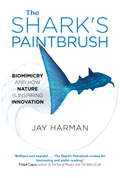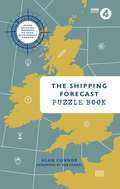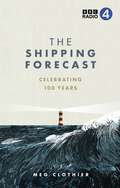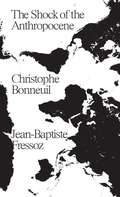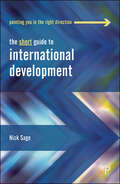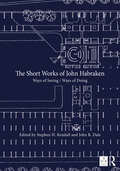- Table View
- List View
The Selected Models of the Mesostructure of Composites: Percolation, Clusters, Force Fields (SpringerBriefs in Physics)
by Alexander HeregaThis book presents the role of mesostructure on the properties of composite materials. A complex percolation model is developed for the material structure containing percolation clusters of phases and interior boundaries. Modeling of technological cracks and the percolation in the Sierpinski carpet are described. The interaction of mesoscopic interior boundaries of the material, including the fractal nature of interior boundaries, the oscillatory nature of it interaction and also the stochastic model of the interior boundaries’ interaction, the genesis, structure, and properties are discussed. One of part of the book introduces the percolation model of the long-range effect which is based on the notion on the multifractal clusters with transforming elements, and the theorem on the field interaction of multifractals is described. In addition small clusters, their characteristic properties and the criterion of stability are presented.
The Self-Potential Method
by André Revil Abderrahim JardaniThe self-potential method enables non-intrusive assessment and imaging of disturbances in electrical currents of conductive subsurface materials. It has an increasing number of applications, from mapping fluid flow in the subsurface of the Earth to detecting preferential flow paths in earth dams and embankments. This book provides the first full overview of the fundamental concepts of this method and its applications in the field. It discusses a historical perspective, laboratory investigations undertaken, the inverse problem, and seismoelectric coupling, and concludes with the application of the self-potential method to geohazards, water resources and hydrothermal systems. Chapter exercises and online datasets and analytical software enable the reader to put the theory in practice. This book is a key reference for academic researchers and professionals working in the areas of geophysics, environmental science, hydrology, and geotechnical engineering. It will also be valuable reading for related graduate courses.
The Self-Sufficient Home: Going Green and Saving Money
by Christopher NyergesHow to cut heating and cooling costs, utilize solar energy, construct nonflush toilets and solar showers, collect rainwater, and apply permaculture techniques. The author explains everything in plain, easily understood, language with hundreds of photographs and diagrams that illustrate ways to use natural resources and embrace self-reliance. Sustainable living advice from self-reliance expert Christopher Nyerges, editor of "Wilderness Way" magazine and author of "How to Survive Anywhere."In an ever-changing economy, cutting costs and utilizing available resources is essential. From embracing solar energy and wind power to using fluorescent bulbs and growing backyard vegetable gardens, there are endless ways to live a more ecological and economical lifestyle. The book offers a collection of testimonials and hordes of practical information on living lightly on the planet.
The Senior Cohousing Handbook: A Community Approach to Independent Living
by Charles DurrettHow to make your senior years healthy, safe, social, and stimulating. "Architect and author Chuck Durrett's recently released book Senior Cohousing Handbook comes at a time of high interest in greening, sustainable housing and affordable living concerns. Durrett's new book is a comprehensive guide for baby boomers wishing to continue vibrant, active lifestyles." - EPR Real Estate News"Make your senior years safe and socially fun with the idea of senior cohousing and a book on the topic that shows how seniors can custom-build their neighborhood to fit their needs. This is housing built by seniors, not for them, and emphasizes independence and social networking. Any library strong in gerontology or social science and many a general lending library needs this. - James A. Cox, The Midwest Book Review"As a Baby Boomer, I've joked for a few years that we'll all end up living communally again because Social Security will be broke...This is one of the better ways to envision it."-- Sacramento Bee No matter how rich life is in youth and middle age, the elder years can bring on increasing isolation and loneliness as social connections lessen, especially if friends and family members move away.Senior cohousing fills a niche for this demographic—the healthy, educated, and proactive adults who want to live in a social and environmentally vibrant community. These seniors are already wanting to ward off the aging process, so they are unlikely to want to live in assisted housing. Senior cohousing revolves around custom-built neighborhoods organized by the seniors themselves in order to fit in with their real needs, wants, and aspirations for health, longevity, and quality of life. Senior Cohousing is a comprehensive guide to joining or creating a cohousing project, written by the US leader in the field. The author deals with all the psychological and logistical aspects of senior cohousing and addresses common concerns, fears, and misunderstandings. He emphasizes the many positive benefits of cohousing, including:Better physical, mental, emotional, and spiritual healthFriendships and accessible social contactSafety and securityAffordabilityShared resourcesSuccessful aging requires control of one’s life, and today's generation of seniors—the baby boomers—will find that this book holds a compelling vision for their future.Charles Durrett is a principal at McCamant & Durrett in Nevada City, California, a firm that specializes in affordable cohousing. He co-authored the groundbreaking Cohousing with his wife and business partner, Kathryn McCamant.
The Sense of Wonder
by Rachel CarsonAn inspiring meditation by one of the best nature writers of the twentieth century, richly illustrated by lush, color photography Rachel Carson shares her prescription for developing a lifelong respect for nature in this deeply personal essay, lavishly expanded and paced by Nick Kelsh's vibrant photography in this posthumously published edition. Using her personal adventures with her young nephew Roger as examples, Carson urges parents to let their children's natural excitement thrive as together they discover the wonders that lie outdoors, from the scuttling of a crab across the cool night sand to a spongy carpet of lichen in a forest. Originally published as a magazine piece, this essay showcases Carson's core belief that a childlike excitement for beauty, for the new and unknown, and for the process of discovery is a gift to be nurtured--a gift that will sustain humanity and the health of the planet on which it depends. This ebook features an illustrated biography of Rachel Carson including rare photos and never-before-seen documents from the Beinecke Rare Book and Manuscript Library at Yale University.
The Serpents of Paradise
by Edward AbbeyThe selections gathered here are arranged chronologically by incident, not by date of publication, to offer Edward Abbey's life from the time he was the boy called Ned in Home, Pennsylvania, until his death in Tucson at age 62.
The Serpents of Paradise: A Reader
by Edward Abbey“[From] a true independent, a self-declared extremist and ‘desert mystic’. . . . outstanding essays, travel pieces, and works of fiction” —BooklistThis book is different from any other Edward Abbey book. It includes essays, travel writing and fictions to reveal Ed’s life directly, in his own words.The selections gathered here are arranged chronologically by incident, not by date of publication, to offer Edward Abbey’s life from the time he was the boy called Ned in Home, Pennsylvania, until his death in Tucson at age 62. A short note introduces each of the four parts of the book and attempts to identify what’s happening in the author’s life at the time. When relevant, some details of publishing history are provided.“This anthology, edited by his longtime editor and friend Macrae, makes for a splendid summary of his best work. . . . Anyone who doesn’t already know his work will find this volume, culled from more than a dozen books of fiction and nonfiction, an addictive introduction.” —Publishers Weekly“If your library is Abbey-deficient, this collection is essential.” —Library Journal“The announcement of a new Abbey book, whether essays or fiction, stirs a personal craving no other current American writer can satisfy.” —Los Angeles Book Review“A record as important and lovely as Muir’s and Thoreau’s.” —Bill McKibben, author of The End of Nature“Abbey’s work is a kind of blessed voice in the wilderness any way you take it, and a precious figure in our lethal time.” —W.S. Merwin, US Poet Laureate
The Settlement of the Chonos Archipelago, Western Patagonia, Chile (The Latin American Studies Book Series)
by Omar ReyesThis book describes an archaeological investigation of human occupation in the northern area of the Patagonian archipelago in the far south of South America. It is of global anthropological and archaeological interest, dealing as it does with an archipelago characterised by a maze of islands, fiords, channels, volcanoes and continental glaciers, in an area which is still very sparsely inhabited with only scattered settlements. It was one of the last parts of the continent to be populated by man, with the arrival of marine hunter-gatherer-fishers. The arrival of human beings in this area, and their subsistence strategies in varied environments, constitute a new example of man's ability to adapt over the course of his history. It is also of interest to document how humans overcome some biogeographical barriers to occupy territories, and how other kinds of barrier restrict movement and access to other regions, leaving certain human groups isolated. Two hunter-gatherer traditions, one marine and one pedestrian, with very different cultural development processes, coexisted in this part of Patagonia separated by less than 100 km of mountains, volcanoes and glaciers. There is no evidence of contact between them over their whole time sequence; on the contrary, the archaeological and bioanthropological evidence indicates two independent axes of movement: one used by canoe groups along the Pacific coast and the other by pedestrian groups in the interior of the continent east of the Andes.
The Shadows of Consumption: Consequences for the Global Environment (The\mit Press Ser.)
by Peter DauvergneAn environmentalist maps the hidden costs of overconsumption in a globalized world by tracing the environmental consequences of five commodities.The Shadows of Consumption gives a hard-hitting diagnosis: many of the earth's ecosystems and billions of its people are at risk from the consequences of rising consumption. Products ranging from cars to hamburgers offer conveniences and pleasures; but, as Peter Dauvergne makes clear, global political and economic processes displace the real costs of consumer goods into distant ecosystems, communities, and timelines, tipping into crisis people and places without the power to resist. In The Shadows of Consumption, Peter Dauvergne maps the costs of consumption that remain hidden in the shadows cast by globalized corporations, trade, and finance. Dauvergne traces the environmental consequences of five commodities: automobiles, gasoline, refrigerators, beef, and harp seals. In these fascinating histories we learn, for example, that American officials ignored warnings about the dangers of lead in gasoline in the 1920s; why China is now a leading producer of CFC-free refrigerators; and how activists were able to stop Canada's commercial seal hunt in the 1980s (but are unable to do so now). Dauvergne's innovative analysis allows us to see why so many efforts to manage the global environment are failing even as environmentalism is slowly strengthening. He proposes a guiding principle of “balanced consumption” for both consumers and corporations. We know that we can make things better by driving a high-mileage car, eating locally grown food, and buying energy-efficient appliances; but these improvements are incremental, local, and insufficient. More crucial than our individual efforts to reuse and recycle will be reforms in the global political economy to reduce the inequalities of consumption and correct the imbalance between growing economies and environmental sustainability.
The Shape and Size of the Earth: A Historical Journey from Homer to Artificial Satellites
by Dino BoccalettiThis book describes in detail the various theories on the shape of the Earth from classical antiquity to the present day and examines how measurements of its form and dimensions have evolved throughout this period. The origins of the notion of the sphericity of the Earth are explained, dating back to Eratosthenes and beyond, and detailed attention is paid to the struggle to establish key discoveries as part of the cultural heritage of humanity. In this context, the roles played by the Catholic Church and the philosophers of the Middle Ages are scrutinized. Later contributions by such luminaries as Richer, Newton, Clairaut, Maupertuis, and Delambre are thoroughly reviewed, with exploration of the importance of mathematics in their geodetic enterprises. The culmination of progress in scientific research is the recognition that the reference figure is not a sphere but rather a geoid and that the earth’s shape is oblate. Today, satellite geodesy permits the solution of geodetic problems by means of precise measurements. Narrating this fascinating story from the very beginning not only casts light on our emerging understanding of the figure of the Earth but also offers profound insights into the broader evolution of human thought.
The Shape of Green: Aesthetics, Ecology, and Design
by Lance HoseyDoes going green change the face of design or only its content? The first book to outline principles for the aesthetics of sustainable design, The Shape of Green argues that beauty is inherent to sustainability, for how things look and feel is as important as how they're made. In addition to examining what makes something attractive or emotionally pleasing, Hosey connects these questions with practical design challenges. Can the shape of a car make it more aerodynamic and more attractive at the same time? Could buildings be constructed of porous materials that simultaneously clean the air and soothe the skin? Can cities become verdant, productive landscapes instead of wastelands of concrete? Drawing from a wealth of scientific research, Hosey demonstrates that form and image can enhance conservation, comfort, and community at every scale of design, from products to buildings to cities. Fully embracing the principles of ecology could revolutionize every aspect of design, in substance and in style. Aesthetic attraction isn't a superficial concern -- it's an environmental imperative. Beauty could save the planet.
The Shape of Things: How Mapmakers Picture Our World
by Dean RobbinsHow did the first people explore the land they lived on? How did civilizations expand their boundaries and chart courses into new lands? Learn about the history of cartography across cultures in this ode to mapmaking through the ages.Join history's first mapmakers as they explore the wonders of the world! In these pages, you&’ll find the tools ancient people used to depict their surroundings, methods different cartographers developed to survey new lands, and how we&’ve arrived at modern mapmaking today. Above all else, the thread that runs throughout thousands of years of civilization is the spirit of exploration that helps us measure the shape of things around us, the world we all share.
The Shape of a Life: One Mathematician's Search for the Universe's Hidden Geometry
by Shing-Tung Yau Steve NadisA Fields medalist recounts his lifelong effort to uncover the geometric shape—the Calabi-Yau manifold—that may store the hidden dimensions of our universe.Harvard geometer Shing-Tung Yau has provided a mathematical foundation for string theory, offered new insights into black holes, and mathematically demonstrated the stability of our universe. In this autobiography, Yau reflects on his improbable journey to becoming one of the world’s most distinguished mathematicians. Beginning with an impoverished childhood in China and Hong Kong, Yau takes readers through his doctoral studies at Berkeley during the height of the Vietnam War protests, his Fields Medal–winning proof of the Calabi conjecture, his return to China, and his pioneering work in geometric analysis. This new branch of geometry, which Yau built up with his friends and colleagues, has paved the way for solutions to several important and previously intransigent problems.With complicated ideas explained for a broad audience, this book offers not only insights into the life of an eminent mathematician, but also an accessible way to understand advanced and highly abstract concepts in mathematics and theoretical physics.“The remarkable story of one of the world’s most accomplished mathematicians . . . Yau’s personal journey—from escaping China as a youngster, leading a gang outside Hong Kong, becoming captivated by mathematics, to making breakthroughs that thrust him on the world stage—inspires us all with humankind’s irrepressible spirit of discovery.” —Brian Greene, New York Times–bestselling author of The Elegant Universe“An unexpectedly intimate look into a highly accomplished man, his colleagues and friends, the development of a new field of geometric analysis, and a glimpse into a truly uncommon mind.” —The Boston Globe“Engaging, eminently readable. . . . For those with a taste for elegant and largely jargon-free explanations of mathematics, The Shape of a Life promises hours of rewarding reading.” —American Scientist
The Shaping of Greenland’s Resource Spaces: Environment, Territory, Geo-Security (Routledge Studies of the Extractive Industries and Sustainable Development)
by Mark NuttallThe book examines ideas about the making and shaping of Greenland’s society, environment, and resource spaces. It discusses how Greenland’s resources have been extracted at different points in its history, shows how acquiring knowledge of subsurface environments has been crucial for matters of securitisation, and explores how the country is being imagined as an emerging frontier with vast mineral reserves. The book delves into the history and contemporary practice of geological exploration and considers the politics and corporate activities that frame discussion about extractive industries and resource zones. It touches upon resource policies, the nature of social and environmental assessments, and permitting processes, while the environmental and social effects of extractive industries are considered, alongside an assessment of the status of current and planned resource projects. In its exploration of the nature and place of territory and the subterranean in political and economic narratives, the book shows how the making of Greenland has and continues to be bound up with the shaping of resource spaces and with ambitions to extract resources from them. Yet the book shows that plans for extractive industries remain controversial. It concludes by considering the prospects for future development and debates on conservation and Indigenous rights, with reflections on how and where Greenland is positioned in the geopolitics of environmental governance and geo-security in the Arctic. This book will be of great interest to students and scholars of environmental anthropology, geography, resource management, extractive industries, environmental governance, international relations, geopolitics, Arctic studies, and sustainable development.
The Shaping of Us: How Everyday Spaces Structure our Lives, Behaviour, and Well-Being
by Lily Bernheimer"You are going to be transported by what Bernheimer has to say. You'll make different decisions and figure out how your brain is working and what should be prioritized in your life" Jo Good, BBC LondonWhat makes everyday spaces work, how do they shape us, and what do they say about us?The spaces we live in - whether public areas, housing, offices, hospitals, or cities - mediate community, creativity, and our very identity, making us who we are. Using insights from environmental psychology, design, and architecture, The Shaping of Us reveals the often imperceptible ways in which our surroundings influence our behaviour.Wide-ranging and global examples cover the differences between personalities and nationalities, explore grass-roots and mainstream efforts to build environments promoting well-being, and look ahead to what will become of us if we don't listen closely to what we know is good for us.You will learn whether you are a natural 'prospector' or 'refuger' in the office environment, what roundabouts and stoplights say about British and American culture, whether you are guilty of NIMBYism or being drawn to 'ruin porn', and how the half-house may be a common sight in the near future.The environments we inhabit define our identities - from the earliest moments of our evolution to the worlds we build around ourselves.
The Shareholder Action Guide: Unleash Your Hidden Powers to Hold Corporations Accountable
by Andrew Behar“A valuable call to action for small shareholders to change the ways big corporations do business.”—Robert Reich, former US Secretary of Labor Want to make misbehaving corporations mend their ways? You can! If you own their stock, corporations have to listen to you. Shareholder advocate Andrew Behar explains how to exercise your proxy voting rights to weigh in on corporate policies—you only need a single share of stock to do it. If you've got just $2,000 in stock, Behar shows how you can go further and file a resolution to directly address the board of directors. And even if your investments are in a workplace-sponsored 401(k) or a mutual fund, you can work with your fund manager to purge corporations from your portfolio that don't align with your values. Illustrated with inspiring stories of individuals who have gone up against corporate Goliaths and won, this book informs, inspires, and instructs investors how to unleash their power to change the world.
The Shark Book
by Steve Jenkins Robin PageCaldecott Honor–winning team Steve Jenkins and Robin Page explore the astonishing lives of sharks in this brilliantly illustrated picture book. Perfect for Shark Week and all year round, this ode to the notorious ocean predator with more than four hundred species will blow you out of the water!Sharp teeth, super senses, and those infamous fins—what's not to love about sharks? Caldecott Honor–winning team Steve Jenkins and Robin Page explore one of the world's most notorious—and fearsome—animals. Learn what makes a shark a shark, what sharks like to eat, and how these predators of the deep have evolved. Ever wonder which shark is the smallest? Or the fastest? Even the most deadly? You'll find your answers in The Shark Book, with countless others. In this magnificently illustrated picture book, celebrate one of the worlds oldest species that has continued to capture our imaginations and astonish us for thousands of years.
The Shark's Paintbrush: Biomimicry and How Nature is Inspiring Innovation
by Jay HarmanThe wave of the future has been around since the beginning of times: it's called Nature. Let inventor and entrepreneur Jay Harman introduce you to stunning solutions to some of the world's thorniest problems. Why does the bumblebee have better aerodynamics than a 747? How can copying a butterfly wing reduce the world's lighting energy bill by 80%? How will fleas' knees and bees' shoulders help scientists formulate a near-perfect rubber? Today an interdisciplinary and international group of scientists, inventors and engineers is turning to nature to innovate and find elegant solutions to human problems. The principle driving this transformation is called biomimicry, and Harman shares a wide range of examples of how we're borrowing from natural models to invent profitable, green solutions to pressing industrial challenges. Aimed at a business audience, aspiring entrepreneurs, environmentalists and general science readers, The Shark's Paintbrush reflects a force of change in the new global economy that does more than simply gratify human industrial ambition; it teaches us how to live in harmony with nature and opens bright opportunities for a better future.
The Sherrington-Kirkpatrick Model
by Dmitry PanchenkoThe celebrated Parisi solution of the Sherrington-Kirkpatrick model for spin glasses is one of the most important achievements in the field of disordered systems. Over the last three decades, through the efforts of theoretical physicists and mathematicians, the essential aspects of the Parisi solution were clarified and proved mathematically. The core ideas of the theory that emerged are the subject of this book, including the recent solution of the Parisi ultrametricity conjecture and a conceptually simple proof of the Parisi formula for the free energy. The treatment is self-contained and should be accessible to graduate students with a background in probability theory, with no prior knowledge of spin glasses. The methods involved in the analysis of the Sherrington-Kirkpatrick model also serve as a good illustration of such classical topics in probability as the Gaussian interpolation and concentration of measure, Poisson processes, and representation results for exchangeable arrays.
The Shipping Forecast Puzzle Book
by Alan ConnorAttention all Shipping Forecast fans. Set sail on a voyage unlike any other...Each day, millions tune in to hear the Shipping Forecast's unique cadence and poetry, words thatturn our island landscape into something strangeand magical. It's almost like a puzzle to be solved...The Shipping Forecast Puzzle Book tests your general knowledge and lateral thinking through a series of fiendish puzzles, in which all the answers can be found on a map as place names on the coasts or in the seas. For example:· An eagle's under this· What a Komodo Dragon really is· Near where someone was horribly cruel to 343 felinesAnd because your voyages trace the shapes of letters of the alphabet, that's just the beginning...With a foreword by Zeb Soanes, the voice of the Shipping Forecast, and fully illustrated with specially commissioned maps, The Shipping Forecast Puzzle Book will help make you a Master of the quizzing world.
The Shipping Forecast: Celebrating 100 Years
by Meg ClothierThere’s a sea lover in every Brit.The Shipping Forecast on Radio 4 has been keeping people in tune with the gloriously fickle British weather for a century, and capturing our hearts and imaginations along the way.Celebrating a hundred years since the first broadcast, this book takes you to the heart of what the Shipping Forecast means to us as a nation. Each of the ten chapters brings you on a fascinating exploration of a different area of our British maritime history, from stormy weather up above to the seabed far below, and from fishing boats and battleships to the songs and poems inspired by the forecast.This joyous book invites you to sail away into the enchanting world of the forecast, and is the perfect companion for anyone curious about our great British skies and seas.
The Shock of the Anthropocene: The Earth, History and Us
by David Fernbach Christophe Bonneuil Jean-Baptiste FressozDissecting the new theoretical buzzword of the "Anthropocene" The Earth has entered a new epoch: the Anthropocene. What we are facing is not only an environmental crisis, but a geological revolution of human origin. In two centuries, our planet has tipped into a state unknown for millions of years. How did we get to this point? Refuting the convenient view of a "human species" that upset the Earth system, unaware of what it was doing, this book proposes the first critical history of the Anthropocene, shaking up many accepted ideas: about our supposedly recent "environmental awareness," about previous challenges to industrialism, about the manufacture of ignorance and consumerism, about so-called energy transitions, as well as about the role of the military in environmental destruction. In a dialogue between science and history, The Shock of the Anthropocene dissects a new theoretical buzzword and explores paths for living and acting politically in this rapidly developing geological epoch.
The Short Guide to International Development (Short Guides)
by Nick SageInternational development is a vibrant, interdisciplinary area of the social sciences. This Short Guide offers a uniquely succinct and balanced account of this politically charged subject. It distils both the classic and newer debates together in a clear framework and illustrates them with contemporary examples. Designed to introduce a wide readership to international development, the book: • considers how far the field has been reconfigured over time and to what extent it is likely to change in the future; • reviews contemporary topics including tourism, migration and digital technologies; • includes distinctive international case studies and examples. By providing a succinct evaluation of competing approaches to, and perspectives on, the idea and practice of international development, this book offers students across the social sciences a distinct and invaluable introduction to the field.
The Short Guide to Sustainable Investing (Doshorts Ser.)
by Cary KrosinskyThe vast majority of invested assets do not consider environmental, social or governance (ESG) factors. Socially responsible investing (SRI) emerged to address these challenges, but it remains largely deployed in "negative strategies" such as sector screening, and continues to be a small investment niche, largely due to perceptions about potential underperformance.Sustainable investing is a new, more positive investment construct, described as "an investment discipline that explicitly considers future social and environmental trends in financial decision making, in order to provide the best risk-adjusted and opportunity-directed returns for investors. By anticipating these trends ahead of the market, sustainable investing seeks to identify 'predictable surprises' that can help maximize value over the long term."This concise guide by one of the sector's leading experts: Disentangles the terminology around SRI and describes a new, positive, opportunities-oriented paradigm for sustainable investing Showcases funds and strategies that are delivering outperformance within ecological limitsSets out the key megatrends and scenarios which investors need to consider, and Offers a practical guide to constructing a sustainable portfolio. This is absolutely essential reading for investors, fund managers and analysts who need to get up to speed on sustainable investing.
The Short Works of John Habraken: Ways of Seeing / Ways of Doing (Open Building)
by Stephen H. Kendall John R. DaleThis book offers, for the first time, access to the chronological arc of John Habraken’s writing in a single collection. Few architects or scholars have so consistently and patiently pursued such a humane and culturally vital set of radical questions related to the behaviour of the built environment as N. John Habraken. From the publication of his first book in 1960, he has quietly helped redraw the map of architectural research, education, practice, design methods and theory. His insights lead us to a better understanding of how the built field works, contributing to the development of methods enabling professionals to contribute to its coherence and resilience. Following an introductory essay by the editors, placing Habraken’s work in context, this collection is organized in two sections and further organized around a number of specific themes: The Built Field; Role of the Architect; Control; Sharing Forms; Examples of Ways of Doing; Open Building; Tools; and Cultivating the Built Environment. A series of interviews with the author enable him to reflect on his journey of inquiry, research, advocacy and teaching – and the relationship between ways of seeing and ways of doing. Offering theoretical perspectives and methodological ways forward, this book will be of interest to architects, planners and urban designers tackling the challenges of the contemporary built environment that Habraken identifies, as well as educators and students.
